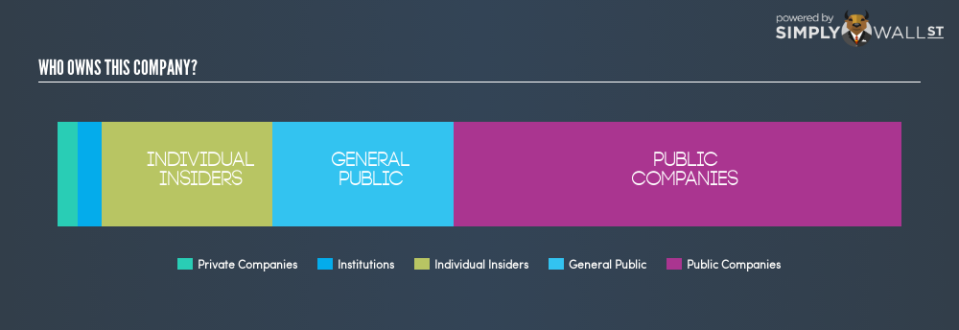What Does Boustead Projects Limited’s (SGX:AVM) Ownership Structure Look Like?

In this article, I will take a quick look at Boustead Projects Limited’s (SGX:AVM) recent ownership structure – an unconventional investing subject, but an important one. Ownership structure of a company has been found to affect share performance over time. The effect of an active institutional investor with a similar ownership as a passive pension-fund can be vastly different on a company’s corporate governance and accountability to shareholders. While this may be more interesting for long-term investors, short-term investors can also benefit by paying attention to when these institutions trade in order to take advantage of the heightened volatility. Now I will analyze AVM’s shareholder registry in more detail.
View our latest analysis for Boustead Projects
Institutional Ownership
Institutional investors are one of the largest group of market participants and their buy-sell decisions on a company’s stock can significantly impact prices, more so, when there are relatively small amounts of shares available on the market to trade. With an institutional ownership of 2.9%, AVM doesn’t seem too exposed to higher volatility resulting from institutional trading.
Insider Ownership
I find insiders are an important group of stakeholders, who are directly involved in making key decisions related to the use of capital. In essence, insider ownership is more about the alignment of shareholders’ interests with the management. A major group of owners of AVM is individual insiders, sitting with a hefty 20.2% stake in the company. Broadly, insider ownership of this level has been found to negatively affect companies with consistently low PE ratio (underperforming). And a positive impact has been seen on companies with a high PE ratio (outperforming). Another aspect of insider ownership is to learn about their recent transactions. Insider buying may be a sign of upbeat future expectations, however, selling doesn’t necessarily mean the opposite as insiders may be motivated by their personal financial needs.
General Public Ownership
The general public holds a substantial 21.5% stake in AVM, making it a highly popular stock among retail investors. With this size of ownership, retail investors can collectively play a role in major company policies that affect shareholders returns, including executive remuneration and the appointment of directors. They can also exercise the power to decline an acquisition or merger that may not improve profitability.
Private Company Ownership
Potential investors in AVM should also look at another important group of investors: private companies, with a stake of 2.5%, who are primarily invested because of strategic and capital gain interests. However, an ownership of this size may be relatively insignificant, meaning that these shareholders may not have the potential to influence AVM’s business strategy. Thus, investors not need worry too much about the consequences of these holdings.
Next Steps:
Institutional ownership level and composition in AVM is not high nor active enough to significantly impact its investment thesis. However, if you are building an investment case for AVM, ownership structure alone should not dictate your decision to buy or sell the stock. Instead, you should be evaluating company-specific factors such as Boustead Projects’s past track record and financial health. I highly recommend you to complete your research by taking a look at the following:
Future Outlook: What are well-informed industry analysts predicting for AVM’s future growth? Take a look at our free research report of analyst consensus for AVM’s outlook.
Past Track Record: Has AVM been consistently performing well irrespective of the ups and downs in the market? Go into more detail in the past performance analysis and take a look at the free visual representations of AVM’s historicals for more clarity.
Other High-Performing Stocks: Are there other stocks that provide better prospects with proven track records? Explore our free list of these great stocks here.
NB: Figures in this article are calculated using data from the last twelve months, which refer to the 12-month period ending on the last date of the month the financial statement is dated. This may not be consistent with full year annual report figures.
To help readers see past the short term volatility of the financial market, we aim to bring you a long-term focused research analysis purely driven by fundamental data. Note that our analysis does not factor in the latest price-sensitive company announcements.
The author is an independent contributor and at the time of publication had no position in the stocks mentioned. For errors that warrant correction please contact the editor at editorial-team@simplywallst.com.

